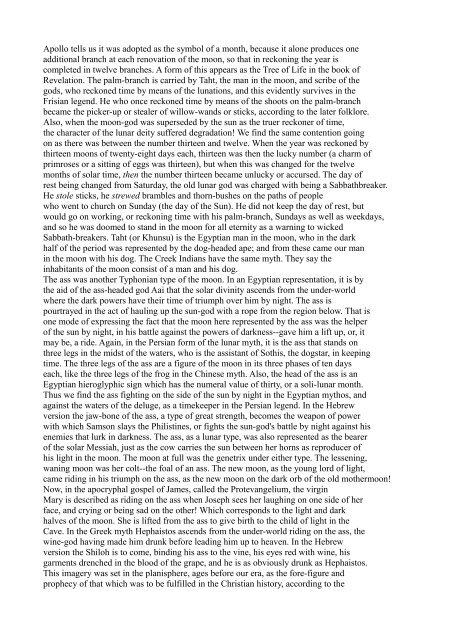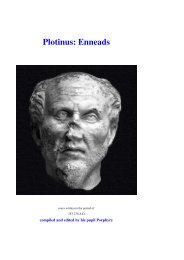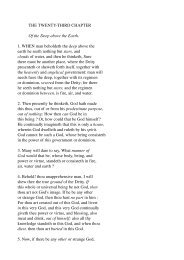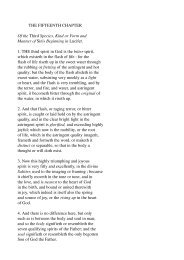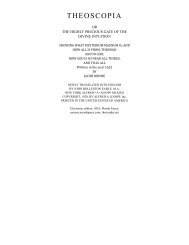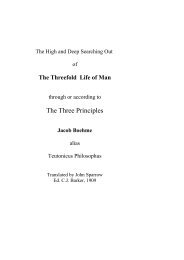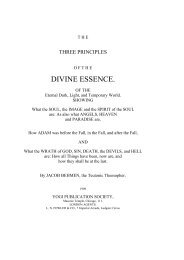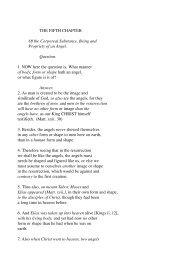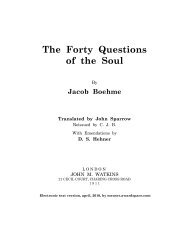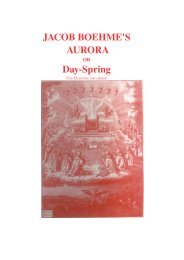Gerald Massey's Lectures - Society in evolution - Awardspace
Gerald Massey's Lectures - Society in evolution - Awardspace
Gerald Massey's Lectures - Society in evolution - Awardspace
Create successful ePaper yourself
Turn your PDF publications into a flip-book with our unique Google optimized e-Paper software.
Apollo tells us it was adopted as the symbol of a month, because it alone produces one<br />
additional branch at each renovation of the moon, so that <strong>in</strong> reckon<strong>in</strong>g the year is<br />
completed <strong>in</strong> twelve branches. A form of this appears as the Tree of Life <strong>in</strong> the book of<br />
Revelation. The palm-branch is carried by Taht, the man <strong>in</strong> the moon, and scribe of the<br />
gods, who reckoned time by means of the lunations, and this evidently survives <strong>in</strong> the<br />
Frisian legend. He who once reckoned time by means of the shoots on the palm-branch<br />
became the picker-up or stealer of willow-wands or sticks, accord<strong>in</strong>g to the later folklore.<br />
Also, when the moon-god was superseded by the sun as the truer reckoner of time,<br />
the character of the lunar deity suffered degradation! We f<strong>in</strong>d the same contention go<strong>in</strong>g<br />
on as there was between the number thirteen and twelve. When the year was reckoned by<br />
thirteen moons of twenty-eight days each, thirteen was then the lucky number (a charm of<br />
primroses or a sitt<strong>in</strong>g of eggs was thirteen), but when this was changed for the twelve<br />
months of solar time, then the number thirteen became unlucky or accursed. The day of<br />
rest be<strong>in</strong>g changed from Saturday, the old lunar god was charged with be<strong>in</strong>g a Sabbathbreaker.<br />
He stole sticks, he strewed brambles and thorn-bushes on the paths of people<br />
who went to church on Sunday (the day of the Sun). He did not keep the day of rest, but<br />
would go on work<strong>in</strong>g, or reckon<strong>in</strong>g time with his palm-branch, Sundays as well as weekdays,<br />
and so he was doomed to stand <strong>in</strong> the moon for all eternity as a warn<strong>in</strong>g to wicked<br />
Sabbath-breakers. Taht (or Khunsu) is the Egyptian man <strong>in</strong> the moon, who <strong>in</strong> the dark<br />
half of the period was represented by the dog-headed ape; and from these came our man<br />
<strong>in</strong> the moon with his dog. The Creek Indians have the same myth. They say the<br />
<strong>in</strong>habitants of the moon consist of a man and his dog.<br />
The ass was another Typhonian type of the moon. In an Egyptian representation, it is by<br />
the aid of the ass-headed god Aai that the solar div<strong>in</strong>ity ascends from the under-world<br />
where the dark powers have their time of triumph over him by night. The ass is<br />
pourtrayed <strong>in</strong> the act of haul<strong>in</strong>g up the sun-god with a rope from the region below. That is<br />
one mode of express<strong>in</strong>g the fact that the moon here represented by the ass was the helper<br />
of the sun by night, <strong>in</strong> his battle aga<strong>in</strong>st the powers of darkness--gave him a lift up, or, it<br />
may be, a ride. Aga<strong>in</strong>, <strong>in</strong> the Persian form of the lunar myth, it is the ass that stands on<br />
three legs <strong>in</strong> the midst of the waters, who is the assistant of Sothis, the dogstar, <strong>in</strong> keep<strong>in</strong>g<br />
time. The three legs of the ass are a figure of the moon <strong>in</strong> its three phases of ten days<br />
each, like the three legs of the frog <strong>in</strong> the Ch<strong>in</strong>ese myth. Also, the head of the ass is an<br />
Egyptian hieroglyphic sign which has the numeral value of thirty, or a soli-lunar month.<br />
Thus we f<strong>in</strong>d the ass fight<strong>in</strong>g on the side of the sun by night <strong>in</strong> the Egyptian mythos, and<br />
aga<strong>in</strong>st the waters of the deluge, as a timekeeper <strong>in</strong> the Persian legend. In the Hebrew<br />
version the jaw-bone of the ass, a type of great strength, becomes the weapon of power<br />
with which Samson slays the Philist<strong>in</strong>es, or fights the sun-god's battle by night aga<strong>in</strong>st his<br />
enemies that lurk <strong>in</strong> darkness. The ass, as a lunar type, was also represented as the bearer<br />
of the solar Messiah, just as the cow carries the sun between her horns as reproducer of<br />
his light <strong>in</strong> the moon. The moon at full was the genetrix under either type. The lessen<strong>in</strong>g,<br />
wan<strong>in</strong>g moon was her colt--the foal of an ass. The new moon, as the young lord of light,<br />
came rid<strong>in</strong>g <strong>in</strong> his triumph on the ass, as the new moon on the dark orb of the old mothermoon!<br />
Now, <strong>in</strong> the apocryphal gospel of James, called the Protevangelium, the virg<strong>in</strong><br />
Mary is described as rid<strong>in</strong>g on the ass when Joseph sees her laugh<strong>in</strong>g on one side of her<br />
face, and cry<strong>in</strong>g or be<strong>in</strong>g sad on the other! Which corresponds to the light and dark<br />
halves of the moon. She is lifted from the ass to give birth to the child of light <strong>in</strong> the<br />
Cave. In the Greek myth Hephaistos ascends from the under-world rid<strong>in</strong>g on the ass, the<br />
w<strong>in</strong>e-god hav<strong>in</strong>g made him drunk before lead<strong>in</strong>g him up to heaven. In the Hebrew<br />
version the Shiloh is to come, b<strong>in</strong>d<strong>in</strong>g his ass to the v<strong>in</strong>e, his eyes red with w<strong>in</strong>e, his<br />
garments drenched <strong>in</strong> the blood of the grape, and he is as obviously drunk as Hephaistos.<br />
This imagery was set <strong>in</strong> the planisphere, ages before our era, as the fore-figure and<br />
prophecy of that which was to be fulfilled <strong>in</strong> the Christian history, accord<strong>in</strong>g to the


